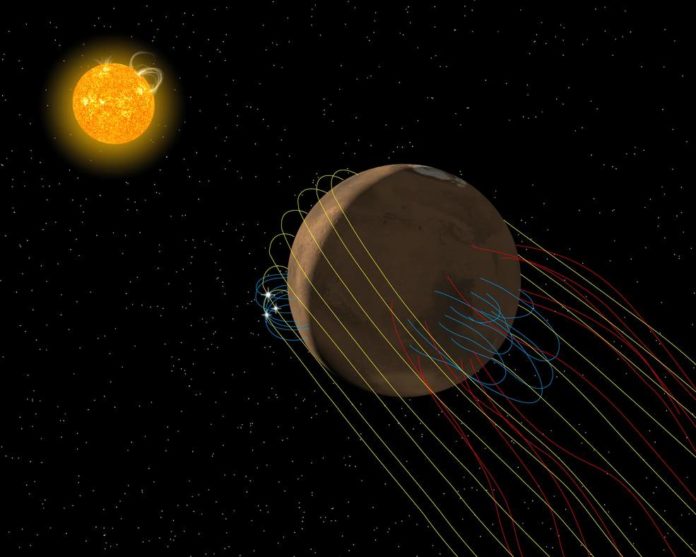A new research by NASA scientists reveals that the planet Mars has an invisible magnetic twisted tail.
NASA’s Mars Atmosphere and Volatile Evolution Mission (MAVEN) spacecraft revolving around mars to gather data about on how the Red Planet lost much of its atmosphere and water. According to scientists, the process that forms twisted tail may help them to understand how its atmosphere escaped mars towards space.
Gina DiBraccio of NASA’s Goddard Space Flight Center in Greenbelt said, “We found that Mars’ magnetic tail, or magnetotail, is unique in the solar system. It’s not like the magnetotail found at Venus, a planet with no magnetic field of its own, nor is it like Earth’s, which is surrounded by its own internally generated magnetic field. Instead, it is a hybrid between the two.”
Scientists think that this magnetotail forms because of the process called ‘magnetic reconnection’. During reconnection, the process may cause a twist in the tail. They say the tail may be formed when magnetic fields carried by the solar wind join with the magnetic fields embedded in the Martian surface in a process called magnetic reconnection. If the solar wind field happens to be oriented in the opposite direction to a field on the Martian surface, the two fields join together in magnetic reconnection.
DiBraccio said, “Our model predicted that magnetic reconnection will cause the Martian magnetotail to twist 45 degrees from what’s expected based on the direction of the magnetic field carried by the solar wind. When we compared those predictions to MAVEN data on the directions of the Martian and solar wind magnetic fields, they were in very good agreement.”
The process magnetic reconnection might escape some of the mar’s atmosphere into space. Mar’s upper atmosphere composed of electrically charged particles i.e., ions that responds to electric and magnetic forces along with magnetic flow lines.
As the Martian magnetotail is framed by connecting surface attractive fields to solar wind fields, ions move to space if they flow down the magnetotail. Thus, magnetic reconnection also releases energy, which could actively propel ions in the Martian atmosphere down the magnetotail into space.
Scientists suspected, “the Martian magnetotail would be a complex hybrid between that of a planet with no magnetic field at all and that found a planet with a global magnetic field. Extensive MAVEN data on the Martian magnetic field allowed us to be the first to confirm this. MAVEN’s orbit continually changes its orientation with respect to the Sun, allowing measurements to be made covering all of the regions surrounding Mars and building up a map of the magnetotail and its interaction with the solar wind.”
